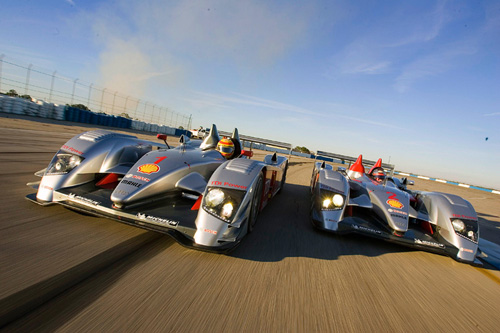Audi debuts 12 Cylinder R10 TDI diesel race car
AUDI AG is once again one step ahead of the opposition: The inventor of ‘TDI’ will become the world’s first automobile manufacturer to fight for overall victory with a diesel engine at the famous 24 Hours of Le Mans. The all-new Audi R10, which was unveiled on Tuesday in Paris, is powered by a totally new 5.5-litre, twelve-cylinder bi-turbo TDI engine, which is extremely quiet and economical.
The Le Mans Prototype, with over 650 hp and more than 1,100 Newton metres torque, significantly exceeds the power produced by the majority of previous Audi racing cars – including that of its victorious R8 predecessor. Audi ventures into previously unexplored diesel-engine terrain with the V12 power plant manufactured completely from aluminium. As with the TFSI technology, which triumphed initially at Le Mans before being adopted for mass-production, Audi customers should benefit once again from the lessons learnt in motorsport.
“With the A8 4.2 TDI quattro, Audi already builds one of the most powerful diesel cars in the world”, explained Prof Dr Martin Winterkorn, Chairman of the Board of Management of AUDI AG, at the R10 presentation in Paris. “The Le Mans project will help our technicians to extract even more from TDI technology. Nowadays, every second Audi is delivered with a TDI engine. We expect that the percentage of diesel engines will be even larger in the future”.
The R10 prototype’s V12 power unit, which is equipped with two diesel particle filters, is hardly recognisable as a diesel thanks to the engine’s smooth running nature. The TDI engine’s specialities presented the Audi Sport engineers with a whole list of challenges. The injection pressure easily exceeds the 1,600 bar achieved in production cars. The usable power band lies between 3,000 and 5,000 revs per minute – an unusually low rev range for a racing engine. The driver must change gear in the R10 far less often than in the R8 because of the TDI engine’s favourable torque curve.
The enormous torque of over 1,100 Newton metres does not only make extreme demands of the R10 transmission system – even the latest generation of engine dynamometers at Audi Sport had to be re-equipped with special gearboxes capable of withstanding the unusual forces.
Additionally, radical changes to the chassis were also necessary. The Audi R10 has a significantly longer wheel base than the R8. The overly wide front tyres are, up until now, unique for a Le Mans Prototype. New technologies were also implemented during the development of the carbon-fibre monocoque. Chassis, engine and gearbox form an extremely rigid, fully stressed unit.
“The R10 project is the biggest challenge ever to have been handed to Audi Sport”, said Head of Audi Motorsport Dr Wolfgang Ullrich. “TDI technology has not been pushed to its limits in motorsport yet. We are the first to confront the challenge. The demands of such a project are accordingly high. Long-term technology partners such as Bosch, Michelin or Shell support us in our quest. Together we have the chance to write new chapters in the history books of motorsport and diesel technology”.
The new Audi R10 successfully completed its first test at the end of November. An extensive test programme, including the 12-hour race at Sebring (USA) on 18 March, is scheduled before the 24 Hours of Le Mans on 17/18 June 2006. The development team from Audi Sport is supported by Reinhold Joest’s squad, which also performed this task during the R8 project.
Copyright © Auto Reviews Online 2016 | Privacy & Terms of Use | info@autoreviewsonline.com | Website by Brolly Media

